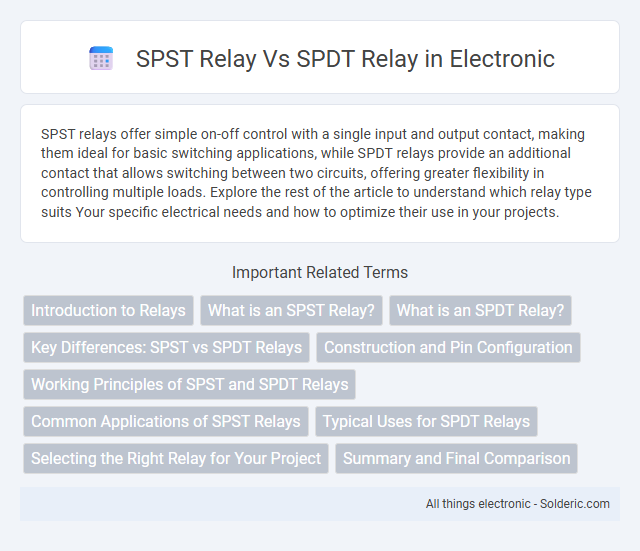SPST relays offer simple on-off control with a single input and output contact, making them ideal for basic switching applications, while SPDT relays provide an additional contact that allows switching between two circuits, offering greater flexibility in controlling multiple loads. Explore the rest of the article to understand which relay type suits Your specific electrical needs and how to optimize their use in your projects.
Comparison Table
| Feature | SPST Relay | SPDT Relay |
|---|---|---|
| Full Name | Single Pole Single Throw | Single Pole Double Throw |
| Number of Poles | 1 | 1 |
| Number of Throws | 1 (ON/OFF) | 2 (Normally Open and Normally Closed) |
| Switching Contacts | One set of contacts | One common contact with two selectable outputs |
| Functionality | Simple ON/OFF switching | Switches between two circuits |
| Typical Use Cases | Basic power control, lighting circuits | Signal routing, multi-function circuits |
| Common Coil Voltage | 5V, 12V, 24V DC typical | 5V, 12V, 24V DC typical |
| Contact Ratings | Varies; typical 10A at 250VAC | Varies; typical 10A at 250VAC |
| Complexity | Simple design | More complex switching |
Introduction to Relays
SPST relay (Single Pole Single Throw) functions as a simple on/off switch controlling one circuit, while SPDT relay (Single Pole Double Throw) switches between two circuits, allowing more versatile control options. Relays use electromagnetic coils to open or close contacts, providing isolation between your control signal and the high-power device. Choosing the right relay depends on the switching needs of your electrical system, whether you require straightforward control or the ability to toggle between circuits.
What is an SPST Relay?
An SPST relay, or Single Pole Single Throw relay, is an electromechanical switch that controls a single circuit by opening or closing one contact pair. It operates as a simple on/off switch, allowing current to flow when energized and stopping current when de-energized, making it ideal for basic control applications. Understanding your SPST relay's function helps in selecting the right component for straightforward switching tasks without the complexity of multiple circuit paths.
What is an SPDT Relay?
An SPDT relay (Single Pole Double Throw) is an electromechanical switch that controls a single circuit by switching between two output contacts, allowing one input to connect to either of two outputs. This relay type offers versatility for applications requiring the selection between two separate circuits, unlike an SPST relay which only switches a single circuit on or off. Understanding the function of an SPDT relay helps you design more flexible and efficient electrical control systems.
Key Differences: SPST vs SPDT Relays
SPST relays have a single pole and a single throw, providing simple on/off control by connecting or disconnecting one circuit. SPDT relays offer a single pole with double throw, allowing the switching between two different circuits or outputs. The key difference lies in SPST's ability to handle only a single path circuit, while SPDT enables selection between two separate circuits, enhancing flexibility in electrical applications.
Construction and Pin Configuration
SPST relays feature a simple construction with two pins representing one switch that is either open or closed, making them ideal for basic on/off control. SPDT relays have three pins, including a common terminal, normally open (NO), and normally closed (NC) contacts, allowing Your circuit to toggle between two different outputs. The pin configuration differences directly affect how the relays connect within an electrical system, determining their application in controlling single or dual circuit paths.
Working Principles of SPST and SPDT Relays
SPST (Single Pole Single Throw) relays operate by connecting or disconnecting a single circuit when energized, acting as a simple on/off switch controlled by an electromagnetic coil. SPDT (Single Pole Double Throw) relays, however, switch a single input between two outputs, allowing your circuit to toggle between two different paths or states. Understanding the working principles of SPST and SPDT relays helps you select the right relay type for your switching needs in electronic and electrical applications.
Common Applications of SPST Relays
SPST relays are commonly used in simple on/off control circuits for devices such as lighting systems, electric fans, and small motors where a single switch operation is required. Their straightforward design makes them ideal for switching power to a load with minimal wiring complexity. Typical applications include activating alarms, controlling pumps, and managing basic electronic signaling systems.
Typical Uses for SPDT Relays
SPDT relays are commonly used in applications requiring the switching between two circuits, such as selecting between two power sources or controlling devices in automation systems. They are ideal for situations where a single control signal must alternate connections, enabling efficient load management and safety mechanisms. Typical industries employing SPDT relays include automotive electronics, industrial machinery control, and home automation systems.
Selecting the Right Relay for Your Project
Choosing between an SPST relay and an SPDT relay depends on your project's switching requirements and circuit complexity. An SPST relay offers simple on/off control with a single pole and single throw, ideal for straightforward applications, while an SPDT relay provides one input and two output paths, enabling you to switch between two circuits or control multiple devices from a single input. Evaluating load type, switching voltage, and control logic helps ensure your selected relay meets performance and reliability standards for optimal system operation.
Summary and Final Comparison
SPST relays feature a single pole and single throw, allowing simple on/off control by connecting or disconnecting one circuit. SPDT relays include one pole and double throw, enabling switching between two different circuits, offering greater flexibility for applications requiring alternate power paths. Your choice depends on whether you need basic switching or more complex circuit control with selectable outputs.
SPST Relay vs SPDT Relay Infographic

 solderic.com
solderic.com